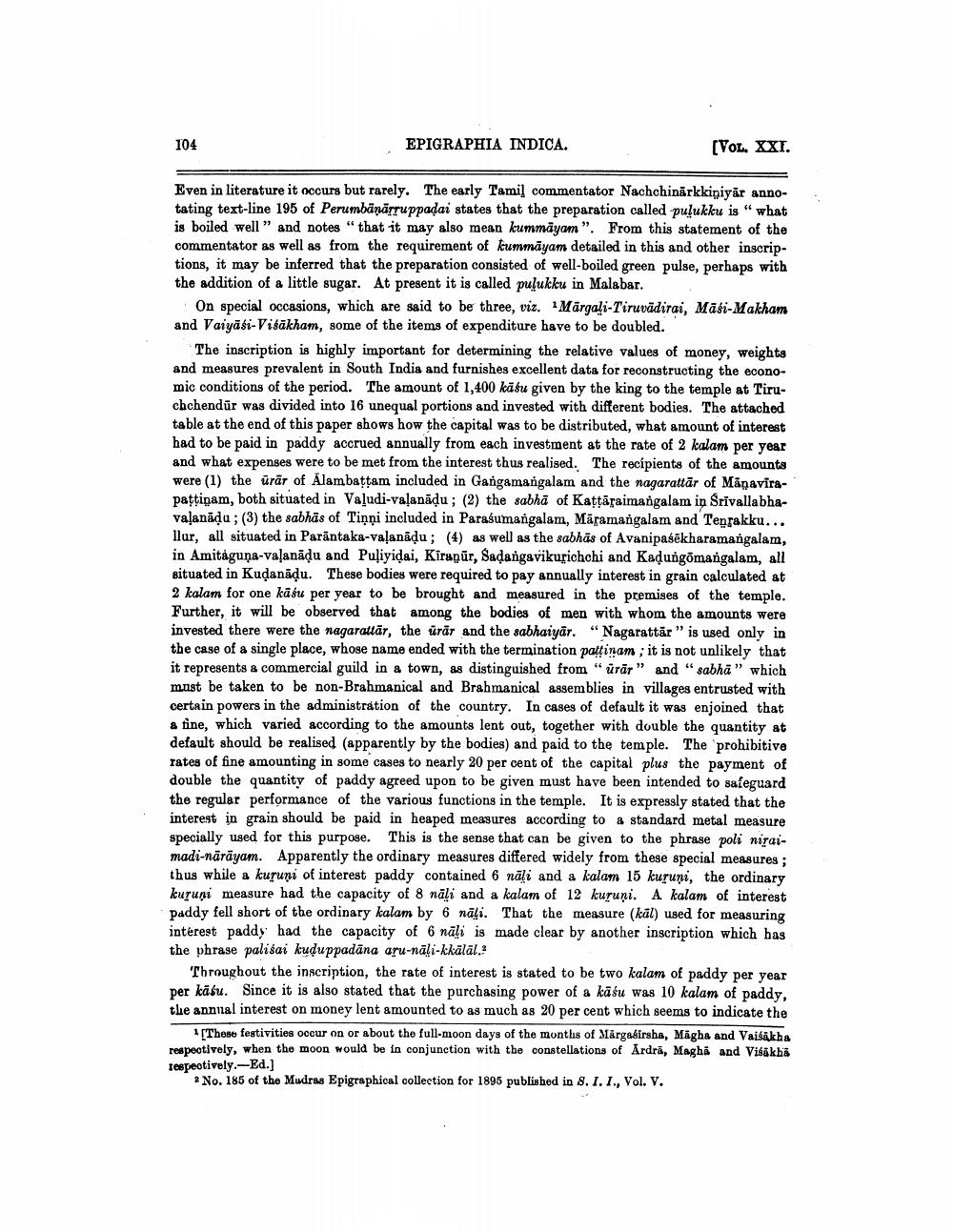________________
104
EPIGRAPHIA INDICA.
(VOL. XXI.
Even in literature it occurs but rarely. The early Tamil commentator Nachchinārkkipiyar annotating text-line 195 of Perumbänārruppadai states that the preparation called pulukku is " what is boiled well” and notes " that it may also mean kummāyam". From this statement of the commentator as well as from the requirement of kummāyam detailed in this and other inscriptions, it may be inferred that the preparation consisted of well-boiled green pulse, perhaps with the addition of a little sugar. At present it is called pulukku in Malabar.
On special occasions, which are said to be three, viz. Märgali-Tiruvādirai, Māsi-Makham and Vaiyasi-Visākham, some of the items of expenditure have to be doubled.
The inscription is highly important for determining the relative values of money, weights and measures prevalent in South India and furnishes excellent data for reconstructing the economic conditions of the period. The amount of 1,400 kātu given by the king to the temple at Tiruchchendur was divided into 16 unequal portions and invested with different bodies. The attached table at the end of this paper shows how the capital was to be distributed, what amount of interest had to be paid in paddy accrued annually from each investment at the rate of 2 kalam per year and what expenses were to be met from the interest thus realised. The recipients of the amounts were (1) the ürār of Alambattam included in Gangamangalam and the nagarattar of Mánavirapattinam, both situated in Valudi-va!anādu; (2) the sabhā of Kattāraimangalam in Srivallabhavaļanāda; (3) the sabhās of Tiņni included in Parasumangalam, Māramangalam and Tenrakku... llur, all situated in Parāntaka-vaļanādu; (4) as well as the sabhās of Avanipaśēkharamangalam, in Amitaguna-valanādu and Puliyidai, Kiraņūr, Sadangavikurichchi and Kadungomangalam, all situated in Kudanādu. These bodies were required to pay annually interest in grain calculated at 2 kalam for one kāśu per year to be brought and measured in the premises of the temple. Further, it will be observed that among the bodies of men with whom the amounts were invested there were the nagarattār, the úrār and the sabhaiyar." Nagarattar" is used only in the case of a single place, whose name ended with the termination pattinam , it is not unlikely that it represents a commercial guild in a town, as distinguished from "urār” and “sabhā” which must be taken to be non-Brahmanical and Brahmanical assemblies in villages entrusted with certain powers in the administration of the country. In cases of default it was enjoined that a fine, which varied according to the amounts lent out, together with double the quantity at default should be realised (apparently by the bodies) and paid to the temple. The prohibitive rates of fine amounting in some cases to nearly 20 per cent of the capital plus the payment of double the quantity of paddy agreed upon to be given must have been intended to safeguard the regular performance of the various functions in the temple. It is expressly stated that the interest in grain should be paid in heaped measures according to a standard metal measure specially used for this purpose. This is the sense that can be given to the phrase poli niraimadi-nārāyam. Apparently the ordinary measures differed widely from these special measures; thus while a kuruni of interest paddy contained 6 nāļi and a kalam 15 kuruni, the ordinary kuruņi measure had the capacity of 8 nāļi and a kalam of 12 kuruni. A kalam of interest paddy fell short of the ordinary kalam by 6 nāļi. That the measure (kāl) used for measuring interest paddy had the capacity of 6 nāli is made clear by another inscription which has the phrase palisai kuduppadāna aru-näli-kkālāl.2
Throughout the inscription, the rate of interest is stated to be two kalam of paddy per year per kafu. Since it is also stated that the purchasing power of a kāśu was 10 kalam of paddy, the annual interest on money lent amounted to as much as 20 per cent which seems to indicate the
1 [These festivities occur on or about the full-moon days of the months of Margasirsha, Mäghs and Vaisakha respectively, when the moon would be in conjunction with the constellations of Ardrā, Magha and Visakha respectively.-Ed.]
* No. 185 of the Mudras Epigraphical collection for 1895 published in 8. 1. 1., Vol. V.




